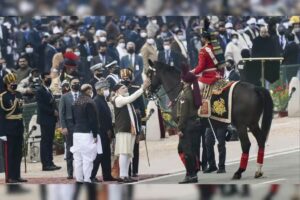
Every autumn in the mid-00s, when I lived in China, my friend Scarlett Li would invite me to Shanghai to eat hairy crab. Named for the spiky fur on their legs and claws, the crabs are said to have the best flavour during the ninth month of the lunar calendar. They’re steamed and served whole, with a dip of rice vinegar spiked with ginger. The most prized specimens come from Yangcheng Lake near Suzhou, which is not far from Scarlett’s home town of Wuxi. She had moved to Hong Kong as a child, attended high school and college in Australia, and returned to China to pursue a career as an entrepreneur. Despite her years abroad, she remained Chinese through and through – and eating hairy crab with her, I became Chinese, too.
Beginning in the Tang dynasty in the seventh century, crabs were harvested from the lakes and estuaries of the Yangtze delta and sent as tribute to the imperial court. Twelfth-century Hangzhou had specialised crab markets and dedicated crab restaurants. “I have lusted after crabs all my life,” wrote the 17th-century playwright Li Yu. “From the first day of the crab season until the last day they are sold, I … do not let a single evening pass without eating them …. Dear crab, dear crab, you and I, are we to be lifelong companions?”
In Invitation to a Banquet: The Story of Chinese Food, Fuchsia Dunlop traces the history of this remarkable cuisine through 30 dishes, from slow-braised pork belly to steamed rice. (There are 10 mentions of hairy crab – not to be confused with crab that’s roasted, baked, shredded, stuffed into soup dumplings or steamed buns, or marinated in liquor and served raw in a dish called drunken crab, which gets its own chapter.) Dunlop, who is British, explores the staggering ingenuity and range of a cuisine that she feels has not won the respect it deserves in the world of fine dining: “Only the Chinese have placed [cooking] at the very core of their identity. For the ancient Chinese, the transformation of raw ingredients through cooking marked the boundary not only between humans and their savage ancestors, but between the people of the civilised world (that is, China and its antecedent states) and the barbarians who lived around its edges.”
The result is a gastronomy that is unparalleled for its diversity, sophistication, subtlety and “sheer deliciousness”. Many supposedly modern ideas about eating, Dunlop points out, have been accepted in China for centuries. Consuming the freshest meat, fish and produce, local and in season, has been important since the earliest dynasties. “Certainly to have a fresh fish and to cause it to become unfresh is a terrible act,” wrote Yuan Mei, an 18th-century gourmet and poet. Educated gentlemen through the ages have searched obsessively for the freshest bamboo shoots, the finest vinegar, or the perfect bowl of congee. (It tastes best, according to one connoisseur, when made with rainwater in early spring.) Ingredients should be cooked in small quantities using refined methods that reveal their benwei, or “root flavours”.
A hairy crab festival in Huai’an, Jiangsu province, in October. Photograph: VCG/Getty Images
The passage of seasons was marked by the fruits and vegetables available in the markets, starting with apricots and cherries in early summer, followed by peaches and melons, then chestnuts, grapes and oranges at the mid-autumn festival and goose pears and quinces at the onset of winter. Everyone knew that the best handmade tofu came from Xiba in Sichuan, just as Nanjing was the place for salted duck, Pixian for chilli bean paste, and the hills around Hangzhou for the most delicate leaves of dragon well green tea. “Concern for the provenance and terroir of ingredients, so important to modern western gourmets, was not the invention of the French or Californians, but has been a preoccupation in China for more than 2,000 years,” Dunlop writes. The Chinese also pioneered imitation meat, free-range chickens, molecular gastronomy, sushi, tofu, soy sauce, ramen and restaurants, which were fashionable gathering places in 12th-century Kaifeng, six centuries before they first appeared in Paris.
Pleasure in eating has always been paired with the need for restraint, and classical texts warned against overindulgence. “Even if there is plenty of meat, [a gentleman] should not eat more meat than rice,” counselled Confucius in the Analects. The ideal has always been to achieve moderation and balance – yin and yang, heating and cooling ingredients, main dishes and rice – in order to nourish the body while living in harmony with nature.
For most of recorded history, ordinary Chinese ate whole grains, legumes and vegetables, used small quantities of meat and fish for flavour, and threw almost nothing away. In rice they found a staple grain that supplies more calories per hectare than any other cereal crop, while myriad preparations of what Dunlop calls the “miraculous” soya bean deliver as much protein as dairy and meat but more economically. This nutritional efficiency allowed China to support a large population on limited arable land, with food that is healthy, satisfying and environmentally sustainable.
Reading Invitation to a Banquet made me think differently about my long-ago crabfests. The Chinese eat freshwater crabs only at the peak of their season, and primarily in the Yangtze delta area near Shanghai. They are cooked and served simply, which allows their benwei to shine. Restraint is built into the experience, yet the freshness, the flavours and the ritual make for meals so satisfying that I can recall them now, detail by detail, 20 years later.
The seductive flavours of China’s local specialities have defined Dunlop’s career. Educated at the University of Cambridge, she first went to live in China in 1994, on a one-year scholarship at Sichuan University in Chengdu to study the government’s policy toward ethnic minorities. She was fortunate to have been sent to a place with one of China’s most distinctive cuisines and found herself taking notes on the food. She quit her studies and enrolled at the Sichuan Higher Institute of Cuisine as one of its first foreign students. Over the past three decades she has built a career explaining Chinese cooking to western readers, initially focusing on Sichuan and then expanding to other regions.
Dunlop making twice-cooked pork with a teacher at the Sichuan Institute of Higher Cuisine, May 2001. Photograph: Lai Wu
More surprisingly, Dunlop has gained a large following by explaining Chinese food to the Chinese. Her memoir Shark’s Fin and Sichuan Pepper sold about 200,000 copies when it came out in China in 2018. Invitation to a Banquet has sold 50,000 copies since its publication there last year, and two of her cookbooks have also done well. Among Chinese food lovers and chefs, Dunlop is praised for her deep understanding of the country’s culinary history. She’s known, like a celebrity, by her first name: “Fu Xia” in Chinese.
How exactly did a waiguoren – a Cambridge-educated white woman who grew up 5,000 miles away – become accepted as an authority on matters so important to the Chinese? Amid China’s rapid transition to a modern industrialised nation, traditional ways of eating and living are disappearing. It has fallen to Dunlop, an outsider, to study the history, to sift through the tradition, and to taste the dishes as if for the first time. Along the way, she has become the voice of a more authentic past. “It kind of shames us, because it’s our own culture,” He Yujia, her Chinese translator, told me. “She helps us rediscover what we’ve neglected for too long.”
Almost 4,000 years ago, Chinese cooking had already developed certain distinctive traits. One was the divide between grain (fan) and vegetable or meat dishes (cai). A meal must include both, and ritual bronze vessels dating to the Shang dynasty, which began around 1760BC, differ depending on whether they were for serving grain or meat. The cutting of ingredients into small pieces, the mixing of meat and vegetables, and the use of diverse seasonings to create highly varied dishes were all in place by the Zhou dynasty, which dates to around 1046BC. (As the 20th-century writer and philosopher Lin Yutang wrote: “The whole culinary art of China depends on the art of mixture.”) From its earliest days, cooking was seen as a subtle and complex undertaking. “Governing a country,” said Laozi, the founder of Taoism, “is like cooking small fish.” His point was that it’s the attention to detail that matters.
During the economic expansion of the Song dynasty, which lasted from 960 to 1279, “the world’s first true cuisine” emerged, as Dunlop writes in her cookbook Land of Fish and Rice. New varieties of rice imported from Vietnam revolutionised farming by allowing the planting of two crops a year, and innovations in cultivation increased yields. The Chinese population boomed, and sophisticated commercial networks sprang up to transport rice, sugar, tea, wine, dried hams and condiments around the country. Novelties like oranges and grapes became widely available, and tea was transformed from a luxury into a daily necessity.
The material abundance of this era, Dunlop writes, spawned “a complex gastronomic culture in which food was not only cooked and enjoyed, but also elaborated, discussed and documented”. Records of the Fresh and Strange, written by a 10th-century scholar and poet, celebrated specialities of the lower Yangtze delta such as sweet pears, loquats and a “noodle so pliable that it could be tied in knots”, as Jin Feng writes in Tasting Paradise on Earth, a history of the region’s food. Su Dongpo, an imperial official and one of China’s most revered poets, wrote about humble dishes of pork and cabbage. (His recipe for turnip soup, which was recorded in 1098, survives to this day.) Appreciation of fine food was a mark of culture, like being accomplished in calligraphy, painting and poetry.
A crab breeding base near Suqian City, Jiangsu province. Photograph: VCG/Getty Images
In 1127, the Song capital city of Kaifeng fell to invaders from Manchuria, forcing the remnants of the imperial court to flee south. On the shores of West Lake they built a new capital, Hangzhou, which became the largest and richest city in the world at that time. On a visit during the late 13th century, Marco Polo was impressed by the numbers of those “accustomed to dainty living, to the point of eating fish and meat at one meal”. With its mix of natives and refugees from the north, the city was something of a melting pot, which was reflected in its cooking. Northern dishes were remade with southern ingredients: shrimp was substituted for mutton, and pastries became lighter and flakier. The fusion of regional cooking styles – the art of mixture, on a large scale – created a truly national cuisine, although not everyone was pleased. “Food and drink have become all confused, with no longer any distinction between southern and northern,” one scholar complained.
In The Eastern Capital: A Dream of Splendour, the twelfth-century gourmet Meng Yuanlao described, street by street and dish by dish, the culinary delights of Kaifeng around 1120, when he lived there as a young man: “Even if there are only two men sitting across from each other, they must use a set of bowls with fluted handles … Even if one drinks alone, such items as silver bowls are used. The fruits and vegetables are fine and exquisite.” He recalled his favourite dishes: quail eggs, fried loyang snow pears.
By the time Meng wrote this, the city as he had known it no longer existed; it had fallen to invaders two decades before. Food is ephemeral, but so are places: buildings, streets, even a flourishing capital can disappear like a fondly remembered meal. At the root of the Chinese gastronomic tradition is a yearning for a lost age. Through words, we create what no longer exists in the world.
Dunlop has engaged deeply with this tradition. She can pinpoint the earliest appearance in the gastronomical literature of soy sauce, the first use of the word for “stir-fry” and the etymological origins of the term dim sum. Like so many of her Chinese predecessors, she regards food with a moralist’s eye. She would like readers not just to appreciate the wonders of Chinese cooking but also to value the healthy and sustainable approach that lies behind it.
In other ways, she blows up the tradition altogether. Dunlop, as a woman who cooks and writes, breaks with a long line of male intellectuals who tended to discourse about food from a certain remove and didn’t actually cook. (The sage Mencius said: “The gentleman keeps his distance from the kitchen.”) Knowing how to eat well was a sign of refinement, but cooking itself has always been low-status. Dunlop’s classmates in culinary school were almost all young men from working-class or rural families.
“If we were making pork balls, we had to pound the meat to a paste with the backs of our cleavers,” she writes. “If we were using walnuts, we had to crack them open, soak them and then, laboriously, peel off their skins.” Cooking is labour, and Dunlop can convey the painstaking multiday process of preparing a dish like braised pomelo pith with shrimp eggs while also tracing the Chinese predilection for using such unlikely ingredients back to the 16th century BC.
Of course, Dunlop’s foreignness also sets her apart. In the extensive coverage of her work and life in the Chinese media, she is “the Cambridge graduate who came to China to cook”, “the English person with a Chinese stomach”, “the foreigner who understands Chinese food best”. “She lends legitimacy to Chinese culture and Chinese cooking at a time when Chinese people really need that affirmation,” Tzui Chuang, a Taiwanese-American food writer, told me.
One of Dunlop’s goals is to rescue Chinese food from its reputation in the west as “popular, but … cheap, low-status and junky”. As she explains in Invitation to a Banquet, the earliest Chinese restaurateurs abroad – beginning with those who went to California during the Gold Rush in the 1840s – were uneducated labourers with no culinary training. The dishes that they made, like deep-fried wontons and sweet-and-sour everything, were nothing like the sophisticated cuisine back home.
A chilli farmer in Fengjiang village, Hunan province, drying chillies for sauce manufacture. Photograph: VCG/Getty Images
Chinese food in the west remained a “bastardised form of Cantonese cuisine”, and this fed a stereotype of the Chinese as slovenly and undiscriminating eaters. Lord Macartney, the leader of a 1793 British diplomatic mission to China, described the Chinese as “foul feeders and eaters of garlic and strong-scented vegetables”. In 2002, the Daily Mail called Chinese food “the dodgiest in the world, created by a nation that eats bats, snakes, monkeys, bears’ paws, birds’ nests, sharks’ fins, ducks’ tongues and chickens’ feet”. More recently, the possibility that the Covid-19 virus emerged in a Chinese market that sold wild animals revived the old “Chinese will eat anything” tropes, though Dunlop notes that consumption of exotic species is limited to a tiny subset of the population and is controversial in China, too.
She takes pains to point out that the Chinese are discerning about ingredients and have always emphasised the links between food and health. The quest for nutritious produce in China created a far more diverse array of foods than is known in the west. Dunlop devotes five pages to the “vast clan of cabbages” before moving on to “the punchy alliums, the tribe of onions and garlics”, and then to bamboo shoots, roots and tubers, gourds, mushrooms and seaweeds. She explores the unfamiliar world of vegetables that are harvested from the water, such as water chestnuts and lotus plants, a category that doesn’t exist in western cooking. She describes the fantastic range of flavours and textures that the Chinese have wrought from tofu, which can be silken or firm, smoked or spiced, stir-fried, deep-fried, frozen, toasted, pressed into sheets, soaked in brine or moulded and fermented into “a delicious state of dishevelment, as high and wild as stilton on the brink between ripeness and decay” – a reminder of the double standards that have made western gourmets devalue Chinese food in favour of their own.
Dunlop also traces the surprising openness of the Chinese to foreign foods throughout history. (Her scholarship builds on Food in Chinese Culture, a classic 1977 study of Chinese food history edited by the archaeologist KC Chang.) During the Han dynasty, which lasted from 206BC to AD220, exotic foods such as grapes, pomegranates, walnuts, sesame, onions, peas, alfalfa, coriander and cucumbers entered the country from central Asia. In the Ming dynasty, which lasted from the mid-14th to the mid-17th century and was known for its isolationist policies, corn, peanuts, white potatoes and sweet potatoes arrived from the new world. Two other new world transplants, the chilli pepper and the tomato, were adopted more recently and further transformed the cuisine.
For a long time historians assumed that Chinese cooking developed its enormous variety because people had to make the most of scarce resources. More recent scholarship suggests that the centrality of food drove innovation. Dunlop underscores the value that the Chinese have always placed on culinary ingenuity: pragmatism and pleasure, not poverty, were always the impetus. To understand the Chinese through their culinary history is also to see them in their best lights – as inventive, adaptable, egalitarian and open-minded. Maybe only a foreigner can see this and say this.
Dunlop’s initial encounters with China took place in what she calls “this prelapsarian world of cooking”. In the early 1990s, families in Chengdu and around the country still cooked dinner on charcoal braziers, made their own pickled cabbage and smoked sausage, and shopped every day for meat and vegetables in open-air markets. In the lanes and alleys of the old city, Dunlop met knife sharpeners and tofu vendors, ate delicious noodle lunches for pennies, and tasted classic Sichuanese dishes like fish-fragrant aubergine and twice-cooked pork for the first time. “On warm evenings we would drift down to the riverbank outside the university, where a rash of alfresco restaurants had sprung up under the wutong trees,” she writes, evoking a lost Eden that she only gradually realised was disappearing.
As the country’s economic progress picked up speed, Dunlop witnessed the demolition of Chengdu’s old wooden houses, streets and entire neighbourhoods to make way for highways and high-rises. “My culinary researches began as an attempt to document a living city,” she writes in her memoir. “Later, it became clear to me that, in many ways, I was writing an epitaph.”
Xie Laoban’s dan dan noodles from Dunlop’s book Every Grain of Rice. Photograph: Martin Poole/The Observer
In the three decades since Dunlop first went to China, the country’s food system has also been transformed. Western fast food restaurants arrived, followed by supermarket chains and megamarkets such as Carrefour and Walmart, all of which led to increased consumption of western-style processed and packaged foods, saturated fats and sugary beverages. “Just like much of the US, it was becoming easier for Chinese urban consumers to buy out-of-season fruit from thousands of miles away than it was to get fresh produce from the farm just outside town,” writes Thomas David DuBois in China in Seven Banquets, a history of Chinese food that gives a good picture of contemporary developments.
A generation ago most Chinese people knew how to cook; in some parts of the country, including Sichuan, it was common for men to be the primary cooks in the family. But rising living standards and a hyper-competitive work culture have changed that. Many Chinese in their 20s and 30s don’t know how to cook or are too busy to do so. According to recent surveys, more than half the population now eats most of its meals outside the home or relies on food delivery services, which have become ubiquitous over the past decade.
Many Chinese are losing touch with the tradition of healthy eating that Dunlop so earnestly celebrates. Consumption of whole grains, legumes and vegetables is in steep decline. According to a 2021 article in the journal Public Health Nutrition, the Chinese now get 30% of their calories from animal products and 29% from industrially processed foods. In 1990, the figures were 9.5% and 1.5%, respectively. Obesity has increased fivefold; the Chinese suffer increasingly from the chronic ailments, such as diabetes and cardiovascular disease, that afflict so many millions in the developed world.
The yearning for a simpler and healthier past informs much of recent Chinese gastronomical commentary. Among the most influential is A Bite of China, a hugely popular TV series that explores the country’s culinary heritage, with episodes on rural villagers harvesting lotus root or making glutinous millet buns using traditional methods. One of China’s biggest social media stars is Li Ziqi, a former nightclub DJ who makes mesmerising, near-wordless videos of herself hiking up hillsides in rural Sichuan to chop firewood and pick mushrooms or planting and harvesting cucumbers, peppers and squash in large bamboo baskets. Nearly every video ends with her cooking dishes over a wood fire and sharing a meal with her grandmother in what looks like a cottage without electricity. Li’s videos, which have gained her tens of millions of followers, present cooking as an extravagant rural fantasy and inadvertently convey how exhausting it is to put dinner on the table.
When Dunlop first lived in Chengdu, she and her classmates frequented a noodle shop near the university that was owned by a man called Xie Laoban – “Boss Xie”. He was a type recognised by anybody who has lived in China – the stony-faced, chain-smoking proprietor who never cracks a smile or says a word in greeting. Over the years, Dunlop returned for a nostalgic bite whenever she passed through the city. She somehow convinced this uncommunicative man to share his recipe for dandan mian, a bowl of noodles topped with crispy minced beef and spicy seasonings that is a classic Chengdu street snack. “In all my wanderings,” Dunlop writes, “I have never come across dan dan noodles as delicious.”
The last time she visited the shop, in 2001, the neighbourhood was being torn down for development: “The lanes around Xie Laoban’s noodle shop lay in ruins, bony cadavers of wood and bamboo, and his restaurant clung to one or two other little shops in a precarious island among them …. I sat there and ate my noodles, which were as fabulous as ever, and then it was time to go. I never saw Xie Laoban again. Later that year, I went to look for him. I wanted to tell him that I had described him and his shop in my Sichuanese cookery book, and published his recipe for dan dan noodles, which was now being read and perhaps cooked by a network of Sichuanese food fans all over the world. But the place where his noodle shop had stood was a moonscape of debris, a great plain of rubble, scattered here and there with shattered pickle jars and rice bowls. And none of the passersby knew where I could find him.”
The food has been eaten; the buildings and people are gone. Only the words remain.
A longer version of this article first appeared in the New York Review of Books
The best stories take time. From politics to philosophy, personal stories to true crime, discover a selection of the Guardian’s finest longform journalism, in one beautiful edition. In the new Guardian Long Read Magazine, you’ll find pieces on how MrBeast became the world’s biggest YouTube star, how Emmanuel Macron deals with Donald Trump, and shocking revelations at the British Museum. Order your copy today at the Guardian bookshop.
Listen to our podcasts here and sign up to the long read weekly email here.





